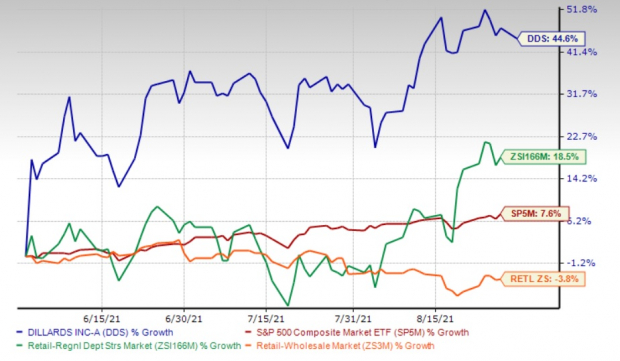Dillard’s Inc.
DDS
is one stock that has been resilient in recent months despite the uncertainties in the markets. Shares of this fashion apparel and home furnishings retailer have been reaping the benefits of stringent inventory management and expense-control measures undertaken to wedge the ill-effects of the pandemic. Apart from these measures, the continued momentum in consumer demand has been contributing to the top and bottom-line gains in the past two quarters.
Notably, the company’s top and bottom lines surpassed the Zacks Consensus Estimate and advanced year over year in second-quarter fiscal 2021. This marked the fifth straight quarter of an earnings beat. Meanwhile, sales have surpassed estimates in the last two quarters, aided by strong consumer demand trends.
Consequently, shares of the Zacks Rank #1 (Strong Buy) company have gained 44.6% in the past three months compared with the
industry
’s growth of 18.5%. Dillard’s has also comfortably outpaced the Retail-Wholesale sector’s decline of 3.8% and the S&P 500 index’s gain of 7.6% during the same period.

Image Source: Zacks Investment Research
In the past 30 days, the company’s estimates for fiscal 2021 and 2022 earnings per share have moved up 55.2% and 43.2%, respectively. For fiscal 2021, its earnings estimates are pegged at $23.54 per share, suggesting significant growth from a loss of $2.73 reported in the prior-year quarter.
Now let us discuss at length the factors that have been aiding the large departmental store chain’s growth.
Dillard’s aggressive measures to lower excess inventory, including cancellation, suspension and delaying of shipments as well as merchandise purchase reduction, have proved beneficial for its margins. As of the end of second-quarter fiscal 2021, inventory declined about 13% year over year to $1,112.8 million. Prior to this, inventory levels were down 17% in first-quarter fiscal 2021 and 26%, 22%, 20% and 14% in the fourth, third, second and first quarter of fiscal 2020, respectively.
Inventory reductions have been resulting in lower markdowns, which are boosting the gross margin. Retail gross margin improved significantly to 41.7% from 31.1% in the year-ago quarter and rose 1,299 basis points (bps) from 28.7% in the second quarter of fiscal 2019. The increase can be attributed to improved consumer demand and better inventory management, which led to lower markdowns in the fiscal second quarter. On a consolidated basis, gross margin of 41% reflects a sharp improvement from 30.4% in the prior-year quarter.
Citing the pandemic-led business disruptions, Dillard’s has taken several steps to reduce costs, starting first-quarter fiscal 2020, which were retained in the second quarter of fiscal 2021. Some of these are extensions of vendor payment terms, the reduction of discretionary and capital expenditure, and payroll reduction.
The company’s consolidated SG&A expenses (as a percentage of sales) contracted 580 bps to 23.3% from the prior-year quarter’s 29.1%. The decline was driven by lower payroll and payroll-related expenses as the company operates with reduced operating hours and fewer associates. The retail SG&A expense (operating expense) rate declined 591 bps to 23.7%. In dollar terms, retail operating expenses fell 10.6% year over year.
The company also remains strong from the balance sheet and liquidity perspective. Some highlights of its financial status include smaller rent obligations compared with the industry. This is because the company owns 90% of its retail stores and 100% of its corporate headquarters, distribution and fulfillment facilities. It has low long-term debt obligations, with its next payment of $45 million due in January 2023.
As of Jul 31, 2021, the company’s long-term debt and finance lease liabilities (including subordinate debentures) of $365.9 million declined 35.3% sequentially. Its debt-to-capitalization ratio of 0.19 represents a sequential improvement from 0.26 as of the end of first-quarter fiscal 2021 and compares favorably with the industry’s ratio of 0.55.
Conclusion
Despite the effects of the pandemic and other inflationary pressures in the industry, we believe that cost- and inventory-management initiatives as well as strong liquidity status position it well for continued growth in the near term. This is further supported by a
VGM Score
of B.
Other Stocks to Consider
Kohl’s Corporation
KSS
has an expected long-term earnings growth rate of 8%. It currently sports a Zacks Rank #1. You can see
the complete list of today’s Zacks #1 Rank stocks here
.
Macy’s, Inc.
M
presently flaunts a Zacks Rank #1. It has an expected long-term earnings growth rate of 12%.
Abercrombie & Fitch Company
ANF
, also a Zacks Rank #1 stock, has an expected long-term earnings growth rate of 18%.
Bitcoin, Like the Internet Itself, Could Change Everything
Blockchain and cryptocurrency has sparked one of the most exciting discussion topics of a generation. Some call it the “Internet of Money” and predict it could change the way money works forever. If true, it could do to banks what Netflix did to Blockbuster and Amazon did to Sears. Experts agree we’re still in the early stages of this technology, and as it grows, it will create several investing opportunities.
Zacks’ has just revealed 3 companies that can help investors capitalize on the explosive profit potential of Bitcoin and the other cryptocurrencies with significantly less volatility than buying them directly.
See 3 crypto-related stocks now >>
Want the latest recommendations from Zacks Investment Research? Today, you can download 7 Best Stocks for the Next 30 Days.
Click to get this free report








